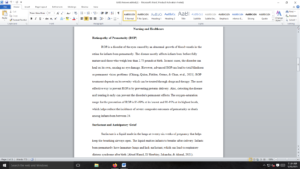Retinopathy of Prematurity
1. Please answer the following questions. Cite the resources utilized for your answers.
A. Discuss Retinopathy of Prematurity (ROP) and how this is managed/prevented. What is the target oxygen saturation range for prevention of ROP?
B. What is surfactant and why is it used in the pre-term infant?
C. Discuss anticipatory grief and correlation with the NICU setting.
D. Discuss medication safety in this patient population. What are the considerations for safe medication administration to this vulnerable population?
2. Tour of the NICU (< 5 mins) Watch
3. Equipment (<7 mins) Watch
4. NICU Training Scenario: Cincinnati Children’s (<9 mins) Watch
**Write a short paper and reflect on what you learned from watching these videos.
Requirements: The answers can be up to 5 sentences. Short paper 500-700 words.
Answer preview
The swell of blood vessels in the light-sensitive layers of the retina causes ROP. Some treatments have side effects, but a combination of medication and therapy can help heal the disease. The standard treatment of ROP is laser therapy which helps burn away the area covering the retina edges with no normal blood vessels (Chiang, Quinn, Fielder, Ostmo, & Chan, et al., 2021). This procedure helps bring sight to the main part of the visual field. Other therapy procedures include cryotherapy, which uses an instrument to freeze certain eye parts that have grown past the retina. The common drug used for the treatment of ROP is Anti-VEGF drugs which help block the continued growth of blood vessels in the retina. Although this drug is not approved by the Food and Drug Administration (FDA), it is used as an alternative to laser therapy.
[773 Words]

Retinopathy of Prematurity

